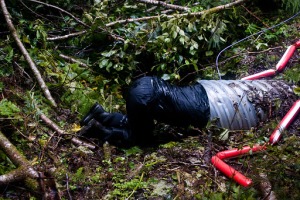Growing up with local foods
Last week was the Sitka Wild Foods potluck, put on by my employers, the Sitka Conservation Society. I already transferred my meager stash of wild food to my freezer in Seattle where I can nostagically eat salmon and huckleberries over the winter, so I didn’t have anything to contribute. But, to the topic of wild and local food, here’s a half written essay on what I ate as a kid, inspired by a question from former supervisor (who is also active on the interwebs!). One thing I see now is that this essay doesn’t mention that my diet as a childhood diverged from the average American diet on account of living in Alaska, as well as having food allergies.
“I want to know what you ate” said Mike, who’d been supervising me for a summer internship. “What was on the table?” I realize now that I should have made a crack about spam, since Mike’s from Hawaii.I had food allergies as a child, so perhaps my diet diverged particularly far from the average American. The main things off-limits were wheat, eggs and chocolate, but I was on an opt-in plan, and went to sleep-overs with a list of allowable foods. If Mike was looking for tales of a subsistence lifestyle, there were three main foods we ate “off the land” and that I still feel strange about buying in the grocery store — fish, rhubarb and blueberries.Rhubarb grew in the yard of our house, near where we had a garden some years. Several starts had been given to my mother by a neighbor, and something about the soil made it very happy. Those rhubarb plants are happily and abundantly growing to this day.Our yard also had a few blueberry bushes, but not enough to feed the family. For that we made a yearly pilgrimage across the Bay to Seldovia in the late summer. In the woods near the head of Seldovia Bay, the blueberries grew thick and sweet in the understory of the spruce forest. We filled five gallon buckets with berries and motored home with purple fingers. The berries would sit in the buckets, with water, for a day to drown out any bugs, then there was endless inspection to remove twigs and leaves before the berries were frozen in the full size freezer in the basement.Fishing was mainly undertaken by my father. He had the magic touch, the siren call that fish could not resist. Or perhaps he enjoyed it more than my mother, and my sister and I were too young to compete. In any case, he was the provider of salmon, Dolly Varden, rainbow trout and so on. Occasionally we also went halibut fishing, which is pure torture as a kid.Here, we’re going to spend all day sitting on the boat, and we want you to do nothing but hold onto this fishing pole and waggle it up and down slowly. Tell us if you feel anything. Oh, and every so often you may reel up two hundred feet of line with a lead sinker attached to check if there is still a third of a herring on the hook for bait. There are exciting stories about halibut fishing – if you catch one big enough, you have to shoot it in order to kill it and keep it from thrashing apart your boat. The trick is to shoot it while it’s still in the water – but, by and large, halibut fishing is a terrible bore.The only thing that kept me interested enough to participate was the knowledge that halibut is a milder taste than salmon. That’s right – I didn’t like salmon. It tasted funny. Now I am happy to get salmon, but when I was eight salmon was yucky, but halibut was pretty good. My favorite halibut dish? Cut in chunks and fried in cornmeal, eaten with ketchup and mustard.Occasionally we had other proteins. We went clamming , although my mother is allergic to shellfish and couldn’t eat any. Clamming was much more interesting than fishing. You got to muck around on the beach, and find all sorts of creatures under rocks. We clammed at Big Jakalof, where there was a dock, and sometimes moored there overnight. Once there was a diver there, who brought up a huge sunflower star, blue and slimy with half a million legs, to the kids who were playing on the dock. Another time we found a wee little octopus and took him back to town for the display at the Pratt Museum.When I was very small, I remember getting crabs and shrimp, but I think later the fishery for those was closed. There were a number of pots, made of rebar and mesh, slowly rusting behind the chicken coop in the yard. I suppose it’s neither fish nor berry, but we kept chickens as well, and collected eggs from them. Most years we got a pair of baby turkeys in the spring and named them Christmas and Thanksgiving. My parents never wanted to dispatch the turkeys in front of the children. One year our husky got loose and took care of it for them. Another year I came home from a slumber party to see nooses draped over the swing set; the turkeys had been executed.I don’t think I was ever very upset about the turkeys, though, as I was never very attached to them. My mother tells me that when I was a year and a half old, they had a batch a leghorns chickens, which roamed loose in the yard rather than being cooped, and were supposed to be able to defend themselves somewhat. One day the rooster attacked me, scratching up my back with his leghorns. He was boiled up, and I’ve never been a big fan of birds.









